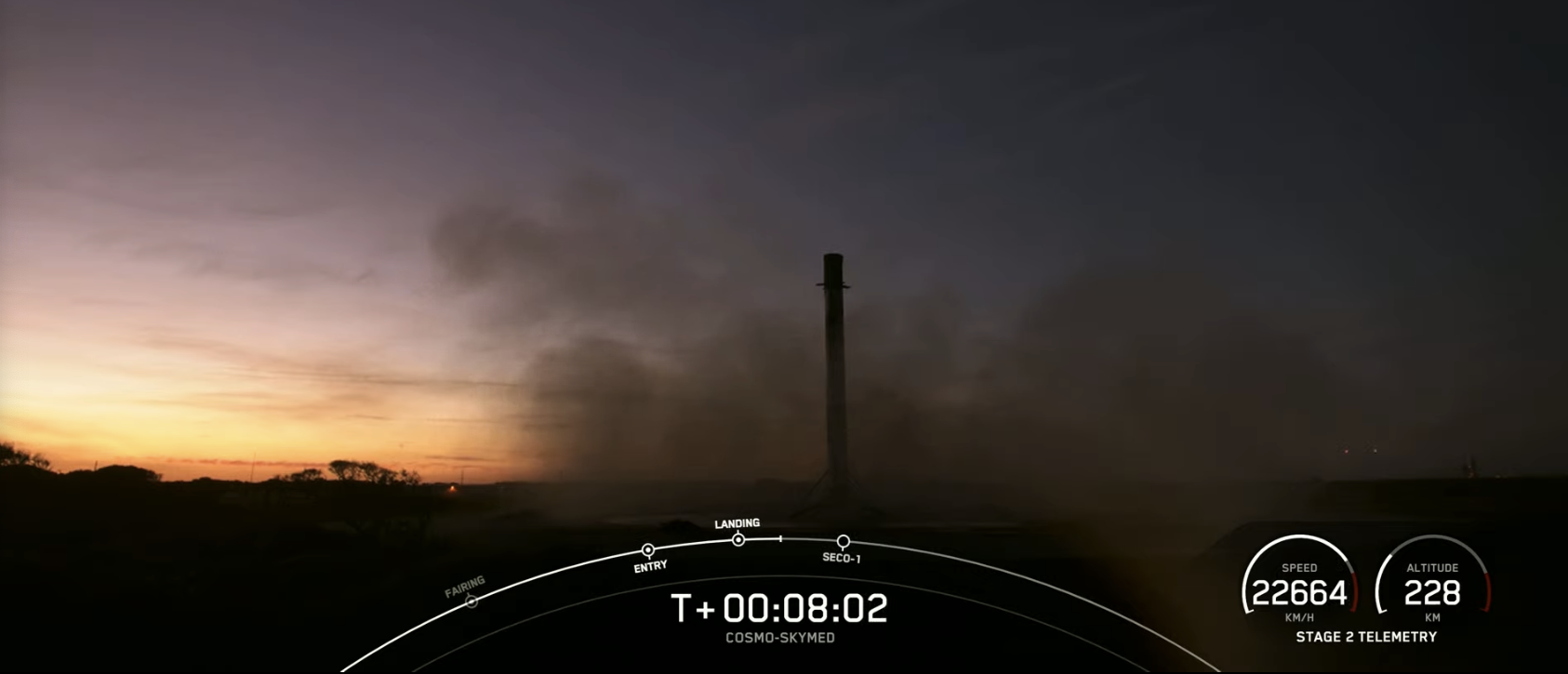
A booster which previously furnished one-third of the muscle to get a pair of SpaceX Falcon Heavies airborne re-entered service Monday evening to begin a new life as a “single-stick” Falcon 9. And it was fifth time lucky, after three weather-related scrubs between Thursday and Saturday, then another 24-hour postponement from Sunday night due to an unauthorized ship in the hazard area.
B1052—which served as a side-booster for the Falcon Heavy when it lofted Saudi Arabia’s powerful Arabsat 6A communications satellite to orbit in April 2019 and the 24-satellite Space Test Program (STP)-2 payload the following June—lifted off as a “converted” Falcon 9 from storied Space Launch Complex (SLC)-40 at Cape Canaveral Space Force Station, Fla., at 6:11 p.m. EST. It successfully delivered a powerful radar-imaging satellite into near-polar orbit on behalf of the Italian Space Agency (ASI).
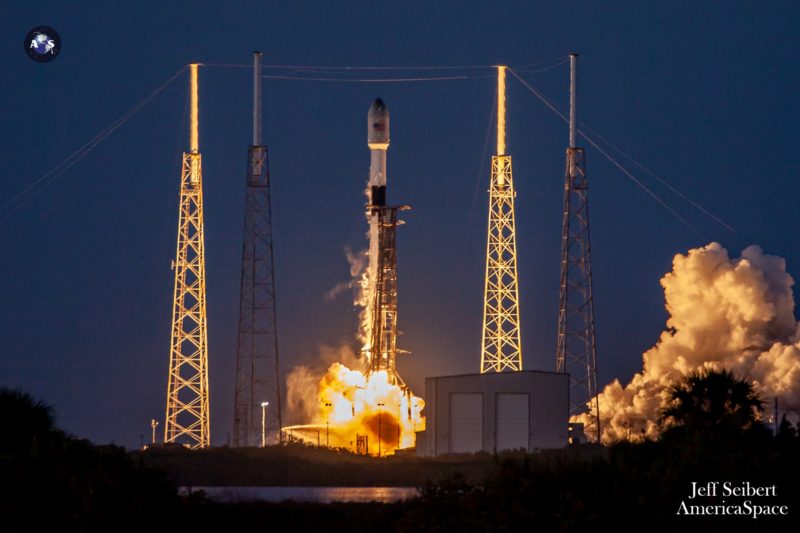
Photo Credit: Jeff Seibert/AmericaSpace
With four missions now under its belt inside January, SpaceX has wrapped up the opening month of 2022 at an impressive launch tempo. And it is a tempo that shows no sign of slowing down.
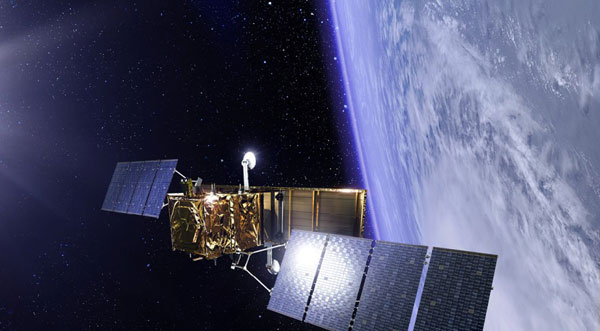
Having successfully boosted the second member of a planned four-strong fleet of COSMO-SkyMed Second Generation (CSG-2) Earth-observation satellites to Sun-synchronous orbit tonight, another Falcon 9 will fly from historic Pad 39A at the neighboring Kennedy Space Center (KSC) as early as Tuesday afternoon, laden with another batch of Starlink low-orbiting internet communications satellites. Coming up after Starlink, SpaceX hopes to return its focus to the West Coast, with NROL-87 set to launch for the National Reconnaissance Office on Wednesday, 2 February.
Its Falcon 9 completed a satisfactory Static Fire Test of its nine Merlin 1D+ first-stage engines at Vandenberg’s Space Launch Complex (SLC)-4E last Wednesday. NROL-87 is one of three classified missions contracted out to SpaceX in February 2019, under a $297 million deal which also includes NROL-85 and USSF-44 for the U.S. Space Force.
Primary payload for Monday’s launch was the 4,800-pound (2,200-kilogram) CSG-2 satellite, built by Thales Alenia Space for the Italian Space Agency (ASI). Encumbered with a lengthy acronym of Constellation of Small Satellites for the Mediterranean Basin Observation (COSMO)-SkyMed, this is the latest addition to a fleet whose ancestry extends back more than a decade.
The four members of COSMO-SkyMed’s first generation rode four of United Launch Alliance’s (ULA) now-retired Delta II boosters out of Vandenberg Air Force Base, Calif., between June 2007 and November 2010. Injected into Sun-synchronous orbits at a mean altitude of 385 miles (619 kilometers), inclined 98 degrees to the equator, these first-generation COSMO-SkyMed satellites utilized X-band Synthetic Aperture Radar (SAR) from their near-polar perches to achieve global coverage of the Home Planet for civilian and military needs.
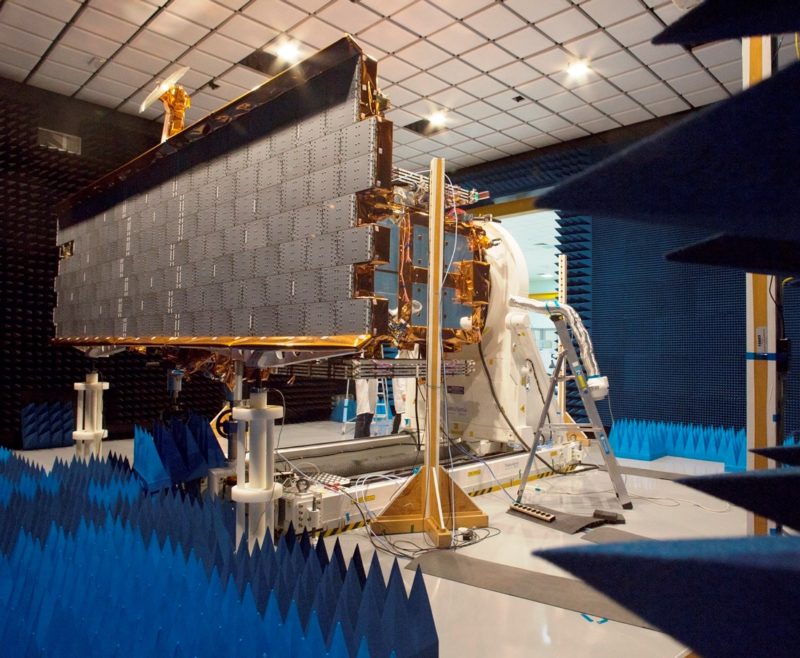
Their 18.7-foot-long (5.7-meter) phased arrays enabled the acquisition of up to 450 daily images and their radar imaging achieved resolutions as fine as 3.3 feet (1 meter) over a 6.2 x 6.2-mile (10 x 10-kilometer) area. Notably, the satellites provided detailed imagery of Central Italy during the 6.5-magnitude earthquake in October 2016 and observed the violent reawakening of the Kilauea Volcano on Hawaii’s Big Island in December 2020.
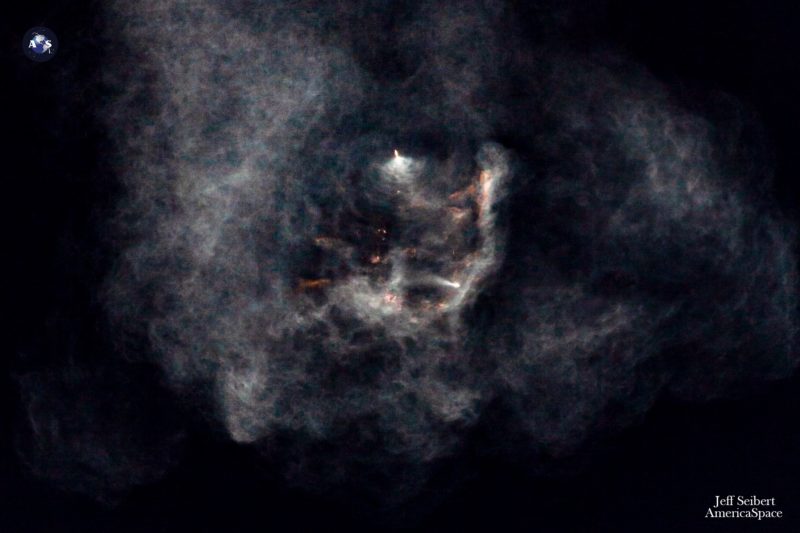
Nebulousness from interaction of first stage boost-back burn (top) and second stage engine burn (lower right).
Photo credit: Jeff Seibert/AmericaSpace
It is expected that the four-strong second-generation COSMO-SkyMed network will achieve higher and much finer imaging resolutions with a more advanced X-band (9.6 GHz) SAR payload suite. Additionally, they benefit from an improved Payload Data Handling and Transmission (PDHT) architecture, which doubles their on-board data-storage capacity and space-to-ground data-transmission throughput over the first generation.

Leading the CSG program and developing the satellites is Thales Alenia Space, with Telespazio responsible for the Ground Segment and Integrated Logistics & Operations (ILS&Ops) services. Thales described the second generation as “a quantum leap in terms of technology, performance and service life”, with an expectation that each of the new satellites will remain operational for a baseline of seven years.
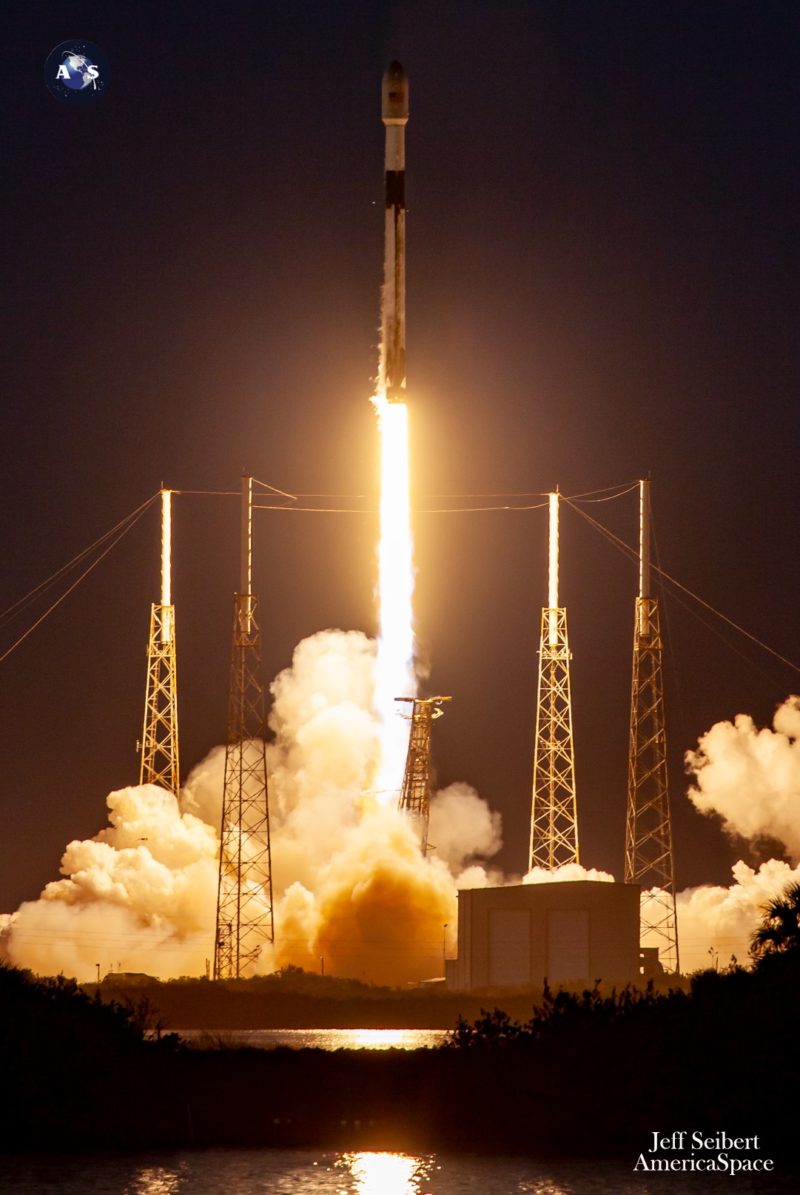
Photo credit: Jeff Seibert/AmericaSpace
Initial contracts between ASI and Thales to execute the program were signed in August 2014, with a follow-up deal inked in September 2015 to specifically complete CSG-2. The second generation passed its Critical Design Review (CDR) in 2015 and wrapped up its Mission-Critical Design Review (M-CDR) in November 2017. Two more satellites—CSG-3 and CSG-4—were added to the Thales contract in December 2020.
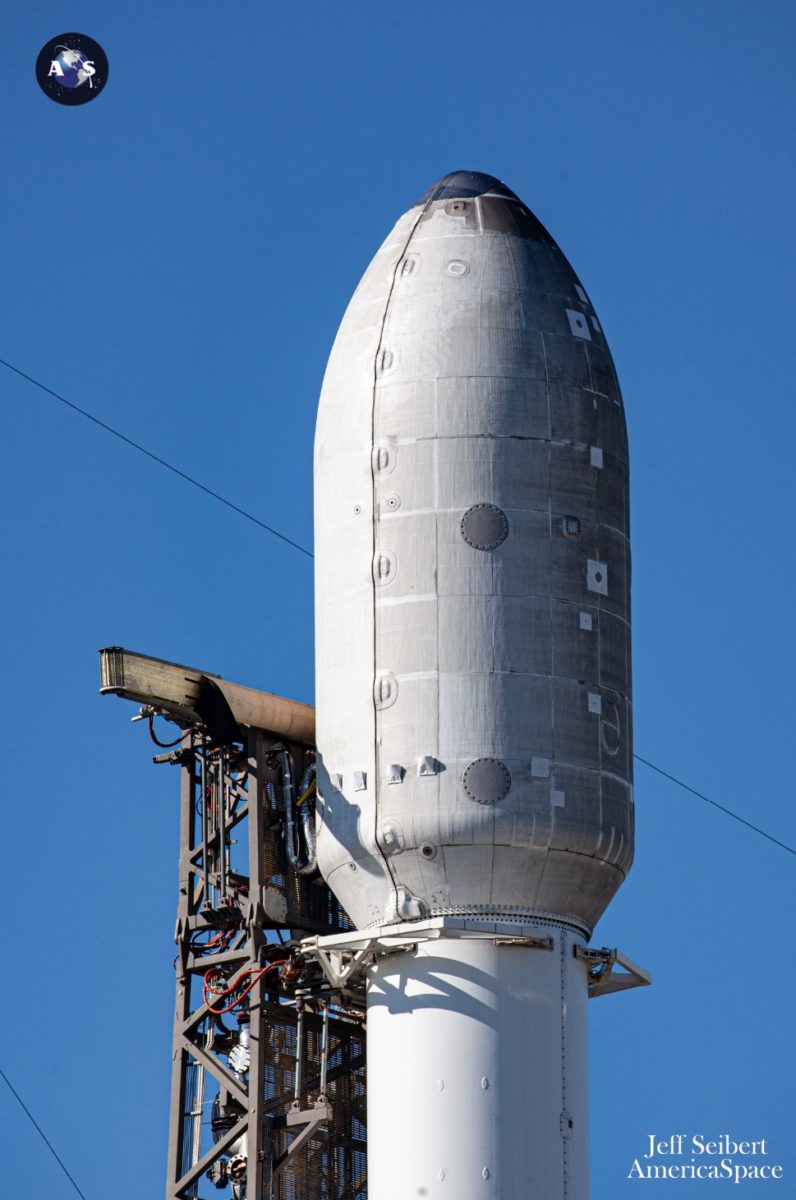
The first member of COSMO-SkyMed’s second generation (designated CSG-1) rose to orbit atop a Soyuz-Fregat booster from Kourou, French Guiana, in December 2019 and pressed directly into an extensive Orbit Test stage to render it capable of fully-fledged collaboration with its first-generation cousins. It was declared fully operational by ASI in January of last year.
According to ASI, original plans foresaw CSG-2 aboard Italy’s as-yet-unflown Vega-C rocket out of Kourou in 2021. But two failures of an earlier incarnation of this vehicle in relatively close succession—the first on the VV-15 mission in July 2019, followed by a second on VV-17 in November 2020—prompted Thales and ASI to opt instead for a SpaceX launch.
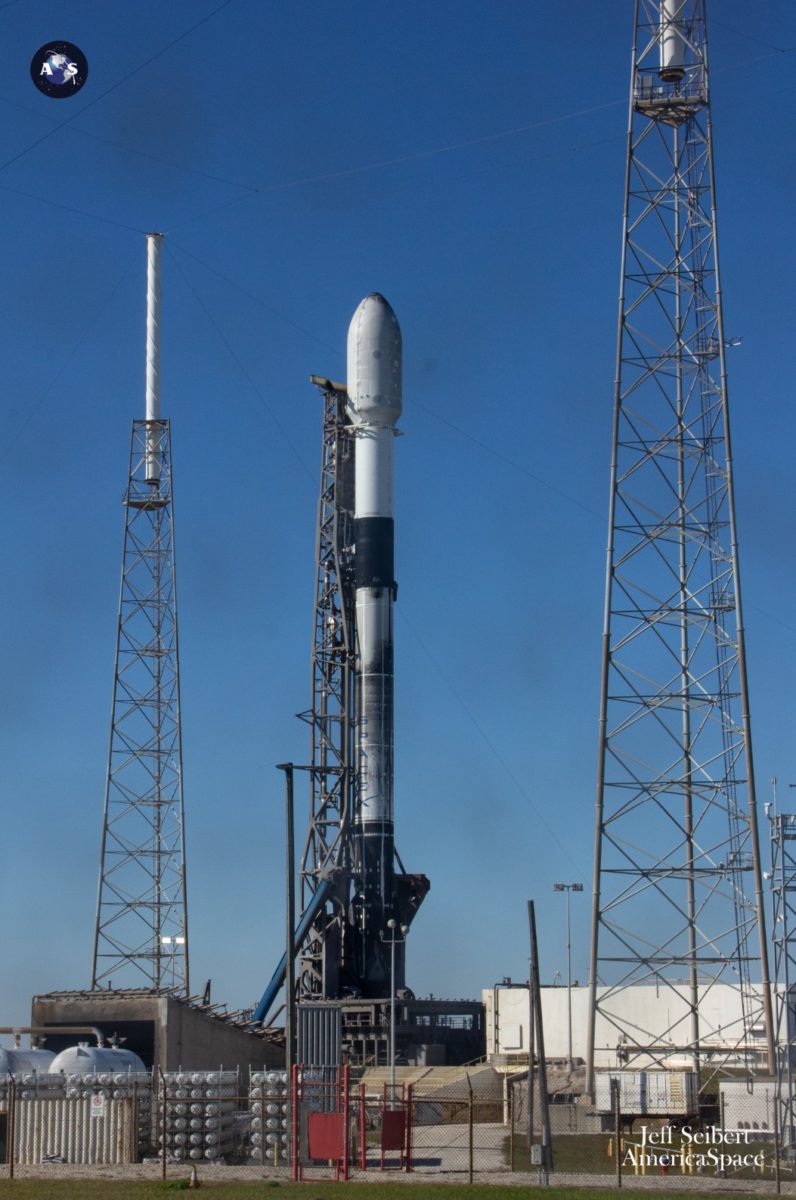
Photo Credit: Jeff Seibert/AmericaSpace
Current plans are for the Vega-C to fly its maiden mission in mid-2022, carrying the Laser Reflectivity Satellite (LARES). This schedule threatened to push the CSG-2 launch even further to the right.
“The launcher development has been impacted by the VV-15 and VV-17 failures and, above all, by the COVID pandemic,” noted ASI last September. “The delays, postponing the Vega-C Maiden Flight to Q1 2022, with a consequent tight schedule of launches in 2022, made the launch period of CSG-2 no longer compatible with the needs of the COSMO Mission. Since ArianeSpace backlog was already full on Soyuz and Ariane systems in 2021, it was not possible to have a European backup solution compliant with the CSG-2 schedule, thus an alternate solution…has been adopted.”
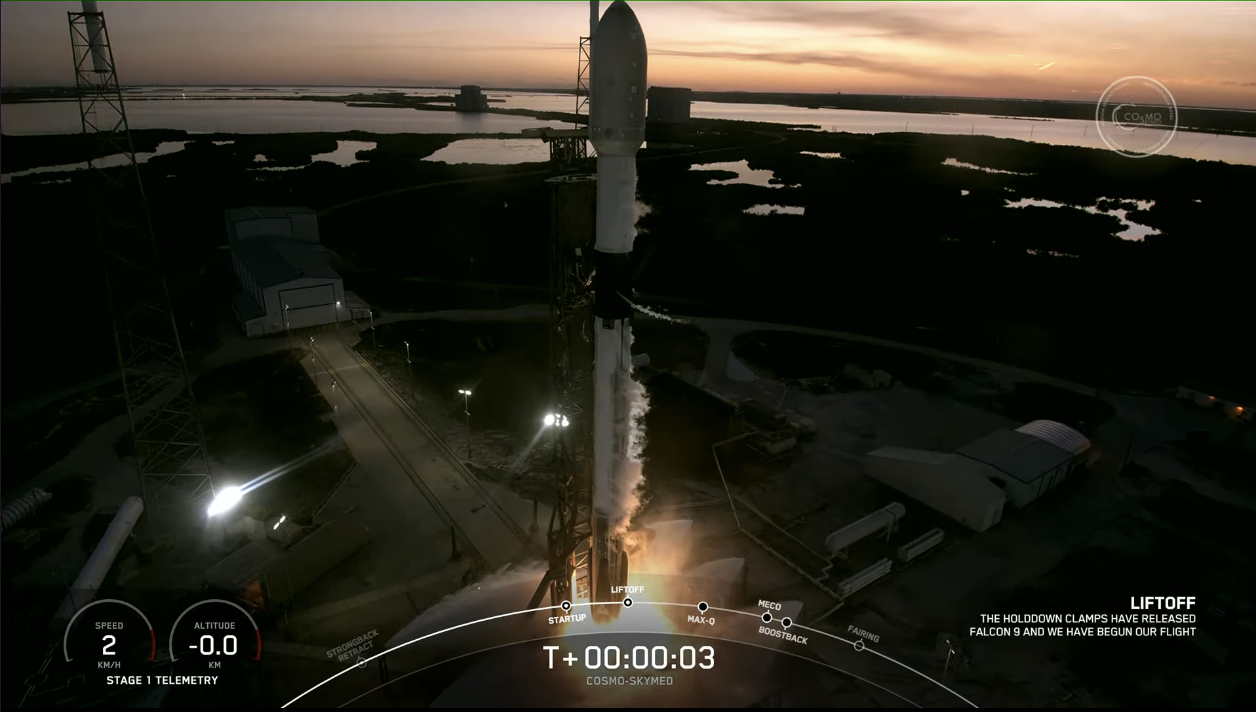
That alternative was SpaceX’s Falcon 9, which including on the eve of tonight’s launch had scored 137 launches since June 2010, with only a single in-flight failure. Contracts were reportedly signed as recently as last September. The CSG-3 mission, targeted for 2024, is still firmly attached to the Vega-C, with the launch vehicle identity for CSG-4 “under discussion”. As such, this was one of the shortest contract-to-launch deals ever snared by SpaceX.
Originally scheduled for November 2021, CSG-2 was pushed into the New Year. Four days before Christmas, the satellite was transported via flatbed truck to Rome’s Fiumicino Airport for loading aboard an Antonov cargo airlifter. It arrived safely at KSC late on the evening of 22 December for pre-flight processing.
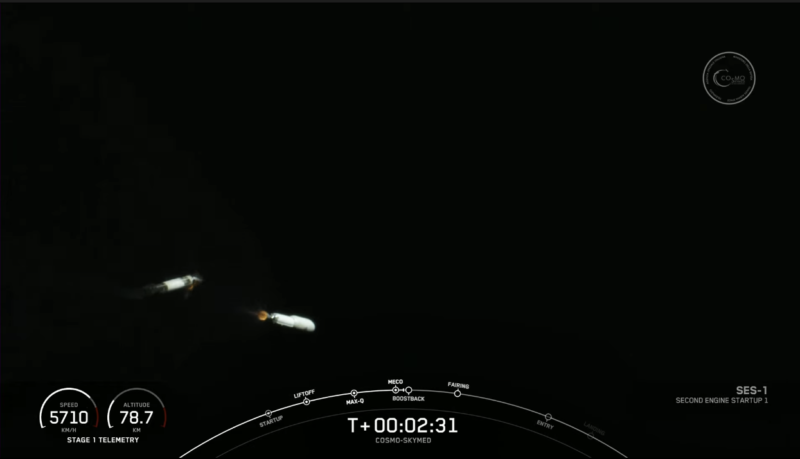
Meanwhile, with three missions already achieved in January, the Falcon 9 assigned to the CSG-2 flight was rolled out of the Horizontal Integration Facility (HIF) and put through a Static Fire Test on Sunday, 23 January. Its nine Merlin 1D+ first-stage engines—which generate 1.5 million pounds (680,000 kilograms) of thrust at T-0—burned furiously for a handful of seconds, before shutting down as planned. The stack was then transported back to the VIF for the integration of the payload fairing and returned to the pad.
Last Tuesday, SpaceX’s “Bob” recovery vessel put to sea and headed for a position almost 370 miles (600 kilometers) south of the launch site, near Cuba, to recover the Falcon 9 fairing halves. But no such departure was intended for the Autonomous Spaceport Drone Ship (ASDS), since B1052 was aiming for a third “land” landing at Landing Zone (LZ)-1 at the Cape. She previously alighted there from both of her Falcon Heavy missions.
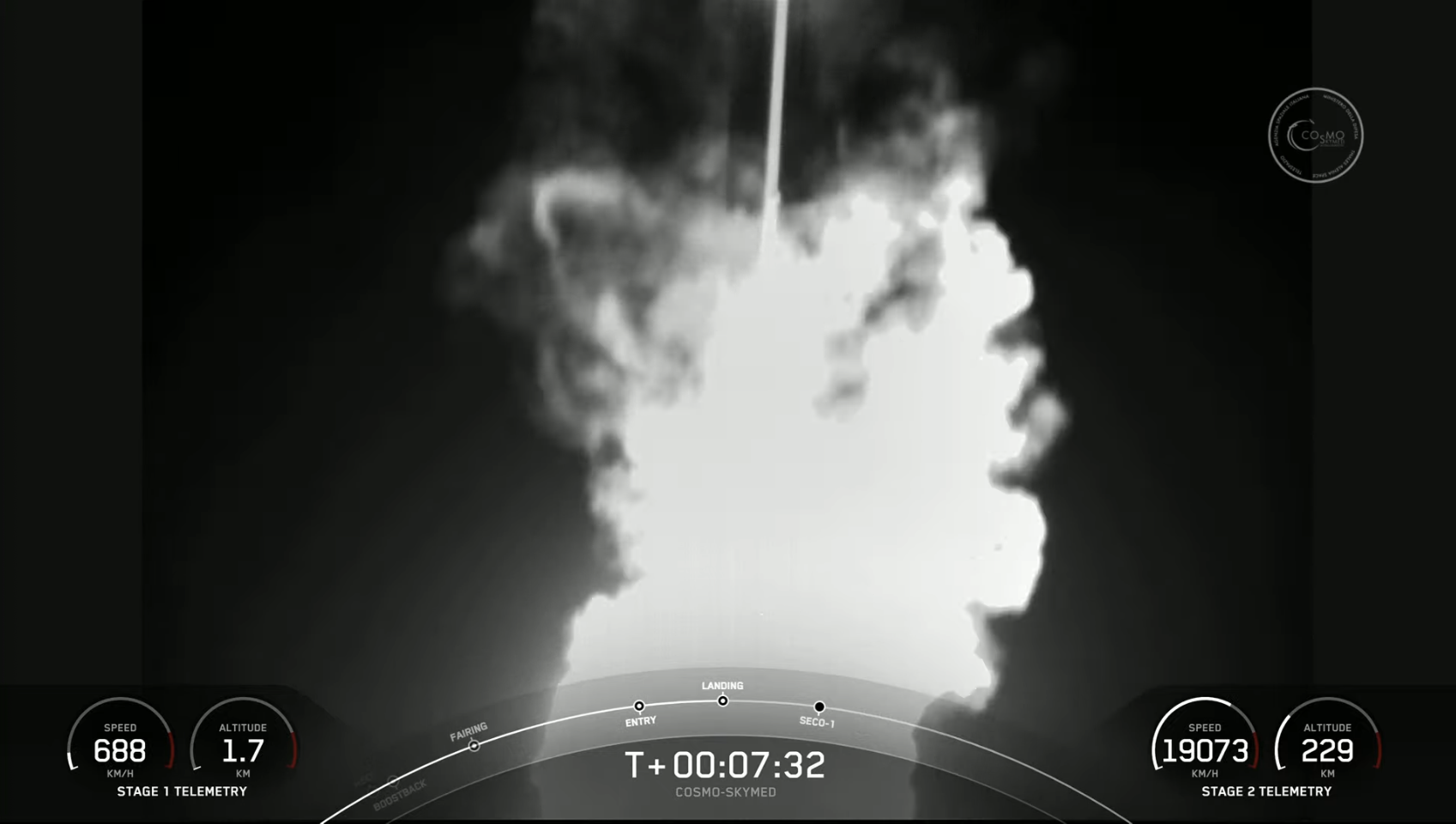
Weather conditions for Thursday’s just-after-sunset launch and a backup attempt on Friday looked iffy, with a 60-percent likelihood of being “Green” at T-0. Disturbed weather in Florida on Wednesday was expected to “support scattered low-topped showers” on Thursday, with a potential to violate the Cumulus Cloud Rule and Liftoff Winds Rule.
This ultimately prompted SpaceX to postpone Thursday’s launch attempt and realign for Friday instead. Conditions proved similarly fruitless on Friday, causing a further slip to Saturday, where conditions were predicted to improve to 80 percent.
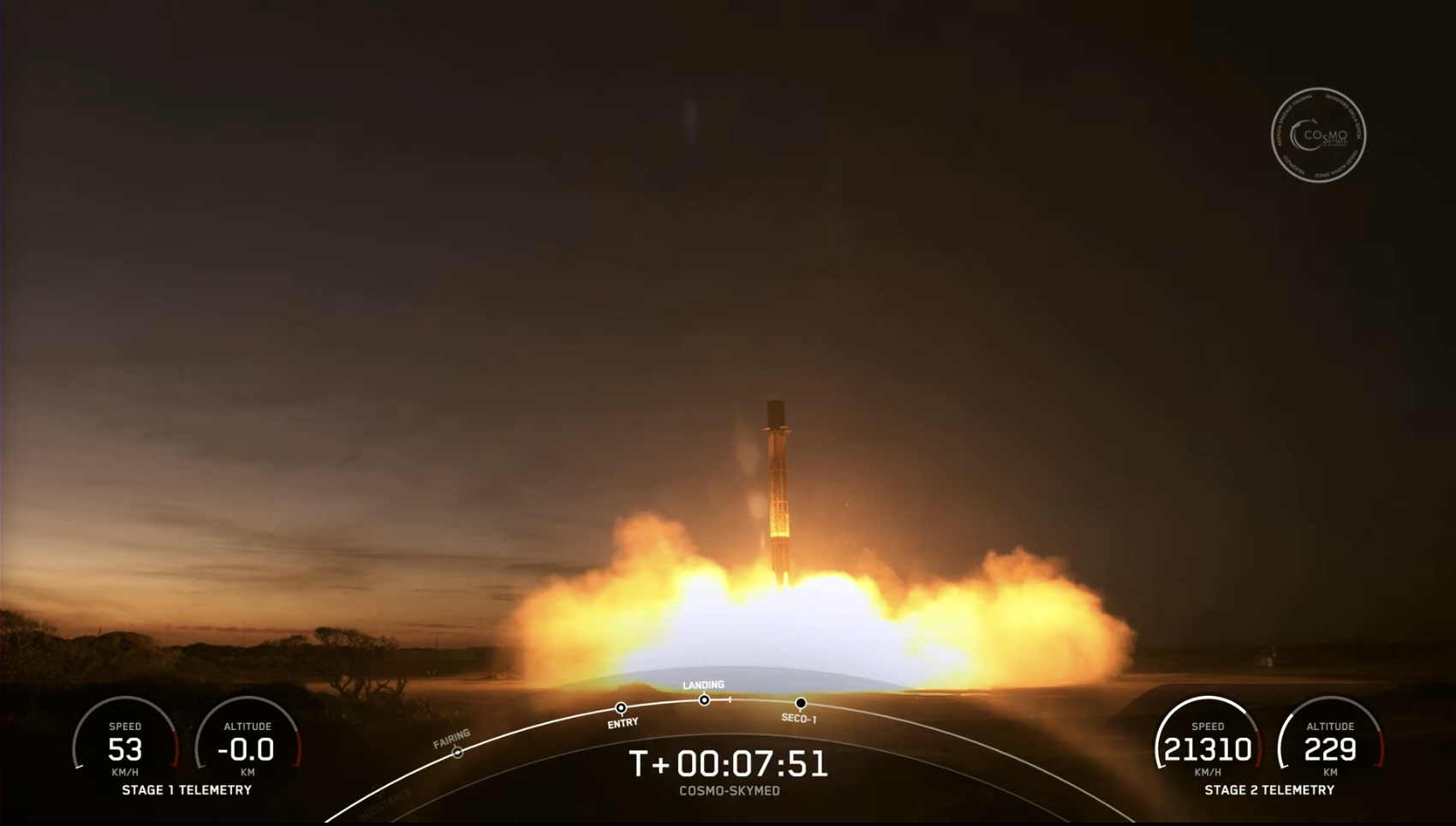
But launch was moved again to Sunday, in response to what SpaceX identified as the weather “affecting pre-launch operations”. However, an unauthorized ship in the hazard area ultimately spelled the end for Sunday’s launch attempt, as the seemingly snakebitten mission succumbed to its fourth back-to-back scrub. Twenty-four hours to the minute later, B1052 took flight at precisely 6:11 p.m. EST Monday, producing a spectacular cusp-of-sunset ascent profile. And less than eight minutes later, the one-time Falcon Heavy side-booster plunged homeward to alight smoothly onto LZ-1.
One previous booster—B1023—was reconfigured from a “single-stick” Falcon 9 into a Falcon Heavy side-booster. It delivered the heavyweight Thaicom-8 communications satellite to orbit in May 2016, before furnishing one-third of the thrust for the very first Falcon Heavy mission in February 2018. But tonight’s mission is the first time that a “used” Heavy side-booster has been reconfigured to fly “single-stick”.
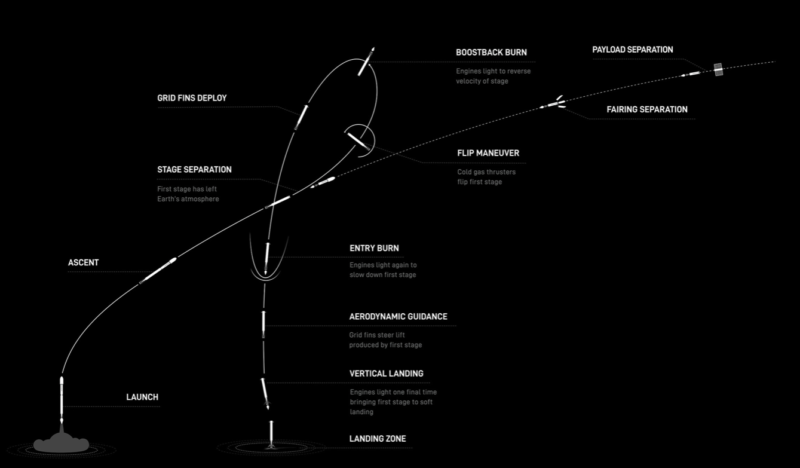
In doing so, she became only the second Falcon 9 to log three LZ-1 landings in her career. With B1052 gone, the Merlin 1D+ Vacuum engine of the second stage executed a standard six-minute “burn” and, following a lengthy period of coasting, CSG-2 was deployed exactly an hour into the mission.
Up next, the six-times-flown B1061 booster, last used to deliver NASA’s Imaging X-ray Polarimetry Explorer (IXPE) last month, will lift dozens more Starlinks to orbit from Pad 39A at KSC as early as 1:56 p.m. EST Tuesday. Attention will then turn to SLC-4E at Vandenberg for the first West Coast launch of 2022, as a brand-new Falcon 9 core carries NROL-87 to orbit on Wednesday morning for SpaceX’s fifth classified mission for the U.S. Government. If the next two launches occur on time, it will be the first occasion that a trio of Falcon 9 missions have flown over three consecutive days.




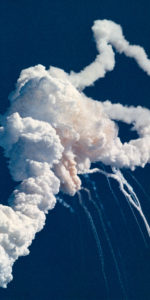

3 Comments
3 Pings & Trackbacks
Pingback:SpaceX Kicks Off Busy February with Classified NROL-87 Launch – AmericaSpace
Pingback:SpaceX Completes Third Mission in Four Days, Pushes Starlink Count Towards 2,100 – AmericaSpace
Pingback:SpaceX Wraps Up Second Four-Launch Month, Looks Ahead to Crewed Missions – AmericaSpace